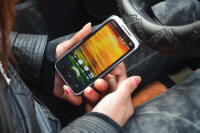Using materials and teaching aids
 |
 |
 |
 |
 |
 |
Task 1:
There are four kinds of aids in the pictures: boards,
projectors, books and phones. Can you think of three
more? Make a few notes and then click here. |
- Recording and playback equipment: video and audio
- Realia
- Paper and pens
- The real world
- The web
 |
 |
Task 2
Think now about how you might use these nine different aids
and make a few notes. Then click here. |
One at a time
boards

Boards are the central and most versatile aid of all. They
don't have to be interactive (although that helps) and they don't
need to be colourful (although that helps, too) but they do have to
be organised.
The board is often the focus of all or part of every lesson.
It is where the learners look for critical information and it is often from
the board that they note things down to take away. That means:
| Don't | Do |
| Use the board
as a kind of jotter. It will soon fill up with all kinds of irrelevance. |
Use the board
to emphasise important things Clean off small items which have simply come up in the lesson and aren't central. |
| Write too quickly or small. | Write clearly –
print if need be. In many cultures, poor handwriting is seen as evidence of poor education. |
| Be random. | Organise things
by position and colour. Your learners will get used to knowing where and in what colour to look for models, new words, instructions and so on and will also assume that what is on the board is crucial in some way. |
| Hog the board. | Allow your learners to use the board to give feedback. |
| Stand between the board and your class. | Make sure the board and everything on it is visible from every seat. |
data projectors

These won't be available everywhere but where they are, they can be a boon. Use them for:
- PowerPoint (etc.) presentations.
- Projecting texts so people are looking up and making eye contact with you rather than looking down to read.
- Projecting material from the web: videos, exercises, news sites, tests, texts etc. etc.
- Students to report back on what they have done with tasks.
- Projecting images and pictures.
books

People like books. Learners like coursebooks because they give a sense of progress and coherence (they are also, incidentally, written by people who have lots of experience and think carefully, usually). Do not fall for the "Oh, I don't like using coursebooks." nonsense. It's how not what.
smart phones

These are underused but many students have them. Their main boon in the classroom is that they can be used to record students talking and to take quick images. You need to consider carefully how that is done and how you will listen to / see the results.
audio and video equipment

There are two different ways to use these:
- As input materials:
Language teachers have long used these aids and, with DVD players and CD players, they have become easier to use. The trick is to be fully acquainted with the equipment so you don't waste time playing with the controls and trying to find the bit on the CD you want to play. Practise.
Beware, too, of overly long sequences. The maximum is around 5 minutes before audio recordings start to wash over people or video recordings become just passively watching TV. At lower levels, one minute is probably the limit.
You need to set the learners clear tasks to achieve before they listen or watch, while they are listening or watching and after they have listened and watched. Make sure there is a purpose to it.
These are aids, not substitutes for the teacher. - To record learners' output:
This use needs a bit more care and expertise to set up but it can be very rewarding to hear oneself speaking a foreign language accurately and comprehensibly. On the other hand, it can be acutely embarrassing to hear oneself speaking it poorly and incomprehensibly.
Handle with care.
realia

Bringing real objects into the classroom can be engaging and motivating (especially if the learners have brought them). Consider, for example,
- Real texts:
A letter / email from a friend or relative of yours or one of the learners is immediately more intriguing than something made up in a coursebook. - Objects:
If your aim is to teach vocabulary for things like fruit, stationery, colours, clothes etc. then having real objects to talk about and describe is motivating and memorable. The same applies to lots of adjective teaching, of course. - Notices, adverts and mini-texts:
Many institutions have places for people to post notices. Exploit them. - Newspapers, brochures and magazines:
can form the basis for a huge range of lessons (not just those focused on reading skills). Get your learners to gather them, if possible. - Don't forget that most of us carry 15 or so items with us at
all times.
In a class of ten, you have a potential 150 objects to talk about, explain and describe. - Personal things:
A useful set of lessons can be built around the learners bringing to class a small object that is, in some way, significant for them and explaining to others what it is, how they acquired it and why it's significant.
paper and pens

Obviously, people need such things in most lessons to take notes
and help them to remember language. Consider, too, whether
feedback from tasks might be more effective and memorable if the
learners present their findings pictorially or graphically.
Younger learners in particular enjoy drawing pictures to explain
things and making colourful charts and posters. Adults are not
immune.
the real world

Even if you are teaching in a non-English speaking environment
(i.e., you are in the huge majority), there will usually be large
numbers of examples of English-language posters, signs and texts.
Get your learners to gather them up and exploit the language in the
classroom.
If you are fortunate enough to be teaching in an English-speaking
environment of course, the possibilities and opportunities to
interact with the language and its speakers are much greater.
Research projects, surveys, service encounters and so on are all
exploitable tasks. There is mileage, for example, in sending
learners to real service offices (such as estate or travel agencies)
to get real information.
the web

The web is, for many, becoming the real world. Even if you don't have in-class access to the web, there are huge numbers of useful resources out here, not least on this site. However, some words of warning:
- Many websites are not reviewed so they constitute the production of individuals and accuracy and fairness may be problematic.
- Websites may contain copyright materials that you can't simply steal (this one is something of an exception). See the charter for how you may use materials you get from ELT Concourse.
- There are probably millions of lesson ideas and plans out here on various commercial and non-commercial websites. Use them with care or your teaching may become just a series of one-off lessons without direction or purpose. If lessons you get from this site or others fit into your course plan, use them. Otherwise leave them alone.
If you want somewhere to start, the pages for teachers and learners of English on this site may be helpful.
